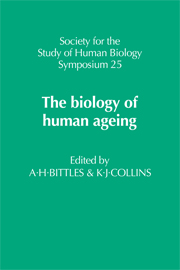Book contents
- Frontmatter
- Contents
- Preface
- Ageing as a consequence of natural selection
- Genetic information in ageing cells
- Insects as models for testing theories of ageing
- Human cell culture systems in the study of ageing
- Estimation of biological maturity in the older child
- Biological age assessment in adulthood
- Skeletal age and palaeodemography
- Cell death and the loss of structural units of organs
- The prospects for mortality decline and consequent changes in age structure of the population
- Where do old people come from? An evaluation of American population projections
- Age structure of Soviet population in the Caucasus: facts and myths
- The health of an ageing population
- Can we tell our age from our biochemistry?
- Dietary manipulation of ageing: an animal model
- Customary physical activity in the elderly
- Effects of ageing on human homeostasis
- Index
Genetic information in ageing cells
Published online by Cambridge University Press: 06 August 2010
- Frontmatter
- Contents
- Preface
- Ageing as a consequence of natural selection
- Genetic information in ageing cells
- Insects as models for testing theories of ageing
- Human cell culture systems in the study of ageing
- Estimation of biological maturity in the older child
- Biological age assessment in adulthood
- Skeletal age and palaeodemography
- Cell death and the loss of structural units of organs
- The prospects for mortality decline and consequent changes in age structure of the population
- Where do old people come from? An evaluation of American population projections
- Age structure of Soviet population in the Caucasus: facts and myths
- The health of an ageing population
- Can we tell our age from our biochemistry?
- Dietary manipulation of ageing: an animal model
- Customary physical activity in the elderly
- Effects of ageing on human homeostasis
- Index
Summary
INTRODUCTION
Fertilization of an egg and the subsequent mixing of maternal and paternal chromosomal complements result in restitution of the diploid state composed of paired allelic sets of genes except, possibly, in the case of the male XY combination. The chromosomal basis of heredity and modality of the parent-to-progeny transfer by Mendelian genetic principles is well established. We also know that the molecular basis of heredity lies in the sequence of trinucleotides in DNA which is, thus, the primary carrier of genetic information. In each species the amount of DNA is maintained at a constant level and the law of DNA constancy is believed to imply that all cells in a lineage contain genetic information which is both qualitatively and quantitatively identical. It is well established that over 90% of the eukaryotic genome is noncoding but the “raisond'etre” for noncoding sequences remains totally obscure. The law of DNA constancy is violated in the case of rDNA amplification during ovogenesis, chromosome elimination from the somatic cell lineage in nematodes, polytenization of chromosomes in diptera larvae, and polyploidization in both animal and plant cells (for details see Davidson, 1976). Cytogenetic maps have been described for a number of species and it is believed that, similar to the germ cells, somatic cells maintain these with fidelity. Since the studies of Hozumi and Tonegawa (1976) on the location of IgG genes, evidence has been accumulating to suggest that the position of one or more genes need not be identical with reference to either each other or, with respect to the total cytogenetic map, even in cells derived from the same lineage.
- Type
- Chapter
- Information
- The Biology of Human Ageing , pp. 17 - 32Publisher: Cambridge University PressPrint publication year: 1986



